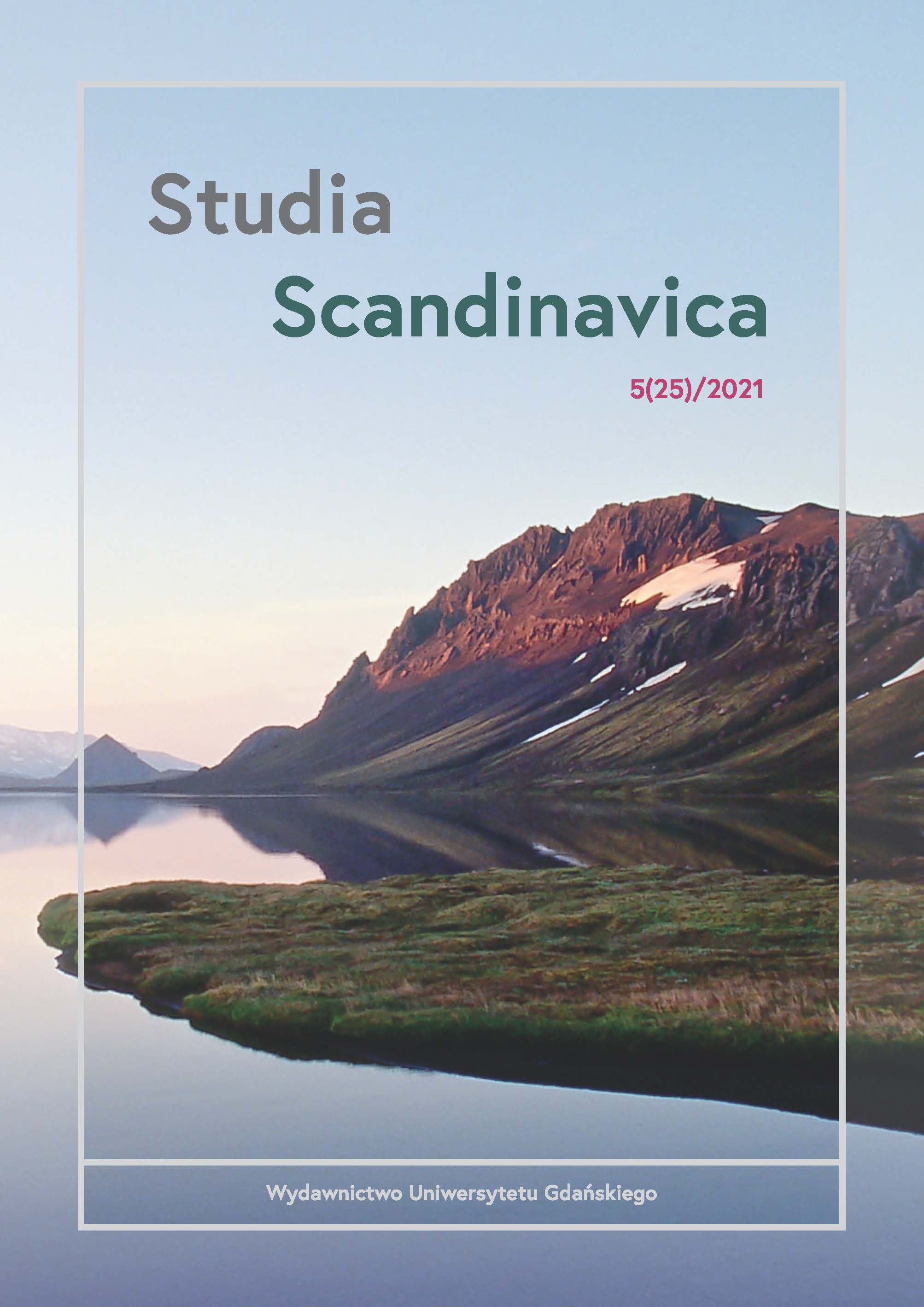Saamowie i ich kultura codzienna w filmie i reportażu z pierwszej połowy XX wieku – rekonstrukcja tożsamości w tekstach kultury
DOI:
https://doi.org/10.26881/ss.2021.25.01Słowa kluczowe:
Saamowie, lud rdzenny, film, reportaż, Szwecja, tożsamość etnicznaAbstrakt
The Saami people are indigenous people and ethnic minorities living in Sápmi, which encompasses the northern areas of Finland, Norway, Sweden, and the Kola Peninsula in Russia. At the beginning of the twentieth century, interest in Saami began to grow among Swedish researchers, journalists, writers, and film-makers (Jordahl 2014). The aim of this article is to compare the depiction of the attributes of Sami identity as reconstructed in cultural texts from the first half of the twentieth century. The main subject of the analysis is the Swedish feature film Midnattssolens son (The Son of the Midnight Sun) directed by Rolf Husberg and Thor L. Brooks from 1939 and the non-fiction book by the Swedish journalist Ester Blenda Nordström Kåtornas folk (People of the Cots) from 1916.
Downloads
Bibliografia
Bergvattenberget,Åsele kommun, https://www.asele.se/fritid-turism-och-kultur/fritidsaktviteter/ vandringsleder/offerhallan/ (dostęp: 5.04.2021).
Bremmer, F. (2017). Ett jävla solsken: En biografi om Ester Blenda Nordström. Stockholm: Bokförlaget Forum.
Burzyńska, J., M. Binkowska-Bury i P. Januszewicz. (2015). Television as a source of information on health and illness – review of benefits and problems. Progress in Health Sciences 5(2): 174–184.
Chandra, K. (2006). What is Ethnic Identity and Why Does it Matter? Annual Review of Political Science 9: 397–424.
Güettler, K. (2020). Flera kopplingar i Sápmi. Kalle Güettler, författare, https://kalleguettler. wordpress.com/2020/01/29/flera-kopplingar-i-sapmi/ (dostęp: 2.04.2021).
Horowitz, L.D. (1985). Ethnic Group in Conflict. Berkley–Los Angeles–London: University of California Press.
Irobi, E.G. (2009). Konflikty etniczne w Afryce w świetle teorii potrzeb ludzkich. Krakowskie Studia Międzynarodowe 1: 232–244.
Jordahl, J. (2014). Hon fick samelivet att kännas ända in på huden. Aftonbladet, 23. stycznia 2014. https://www.aftonbladet.se/kultur/a/m6zwaL/hon-fick-samelivet-att-kannas-anda- -in-pa-huden (dostęp: 6.04.2021).
Klein, E. (1916). Kåtornas folk. Idun, 24. grudnia 1916.
Labba, E.A. (2020). Herrarna satte oss hit. Stockholm: Norstedts. Lehr, U. (2003). Oblicza starości. Etnografia Polska 47(1–2): 71–102.
Legare, A. (2013). The Reconstruction of Inuit Collective Identity: From Cultural to Civic: The Case of Nunavut. W: J.P. White, S. Wingert, D. Beavo i P. Maxim (red.). Volume 4: Moving Forward, Making a Difference. Seria: Aboriginal Policy Research. Ottawa: Thompson Educational Publishing, s. 103–121.
Lubowicka, A. (2011). Anaruk i Odarpi – szlachetne dzikie dzieci w eskimoskim skansenie. Z problematyki egzotyzacji eskimoskiej w polskie literaturze. W: H. Chojnacki, A. Kubka, E. Mrozek-Sadowska i M. Sibińska (red.). W poszukiwaniu tożsamości skandynawskiej i polskiej. Studia o literaturze i społeczeństwie. Gdańsk: Wydawnictwo Uniwersytetu Gdańskiego, s. 99–115.
Mccann-Mortimer, P., M. Augoustinos i A. Lecouteur. (2004).‘Race’ and the Human Genome Project: Constructions of Scientific Legitimacy. Discourse & Society 15(4).
Mecsei, M.K. (2015). Cultural Stereotypes and Negotiations in Sámi Cinema. W: S. MacKenzie i A. Westerståhl Stenport (eds.). Film on Ice: Cinemas of the Arctic. Edinburgh: Edinburgh University Press.
Norberg, E. (2014a). Samer utmålas som obildade och barnsliga. Aftonbladet, 11. stycznia 2014. https://www.aftonbladet.se/debatt/a/21j06R/samer-utmalas-som-obildade-och-barnsliga (dostęp: 31.03.2021).
Norberg, E. (2014b). Groteskt att kalla boken en hyllning. Aftonbladet, 15. stycznia 2014. https://www.aftonbladet.se/debatt/a/a2KB3M/groteskt-att-kalla-boken-en-hyllning (dostęp: 31.03.2021).
Nordström, E.B. (1916). Kåtornas folk [Lud namiotów]. Stockholm: Wahlström & Windstrand.
Oscarsson, E.O. (2016). Kåtasystemet ägde det allra närmaste samband med lapparnas sedvänjor. W: K. Huuva i E. Blind (red.).“När jag var åtta år lämnade jag mitt hem och jag har ännu inte kommit tillbaka” Minnesbilder från samernas skoltid. Stockholm: Verbum, s. 85–108.
Paulaharju, S. (1934). Tunturien yöpuolta: vanhoja tarinoita. Helsinki: Porvoo. Paulaharju, S. (1972). Nocne cienie tunturi. Tłum. C. Lewandowska. Poznań: Wydawnictwo Poznańskie.
Pilipiuk, A. (2017). Raport z Północy. Lublin: Fabryka Słów. Redakcja Bakhåll. (2014). Boken är en hyllning till samerna. Aftonbladet, 13. stycznia 2014. https://www.aftonbladet.se/debatt/a/4dWKMe/boken-ar-en-hyllning-till-samerna (dostęp: 31.03.2021).
Roderick. (1939). Midnattssolens Son. Svenska Dagbladet, 8. grudnia 1939.
Samiskt informationscentrum. (2021a). Språk, dialekt eller varietet, http://www.samer.se/1186 (dostęp: 2.04.2021).
Samiskt informationscentrum. (2021b). Sápmi, http://www.samer.se/1002 (dostęp: 2.04.2021).
Samiskt informationscentrum. (2021c). Att skriva på samiska, http://www.samer.se/skriftspraket (dostęp: 4.04.2021).
Samiskt informationscentrum. (2021d). Långa skallar och korta samer, http://www.samer. se/1028 (dostęp: 4.04.2021).
Sibińska, M. (2016). Saamskie teatry: między lokalnością a obcością? Folia Scandinavica 19: 233–249.
Sjöberg, F. (2013). Kärv vildmarskromantik. Svenska Dagbladet, 19. grudnia 2013.
Stoor, K. (2016). Svenska kyrkan och jojken. W: D. Lindmark i O. Sundström (red.). De historiska relationerna mellan Svenska kyrkan och samerna: en vetenskaplig antologi. Skellefteå: Artos & Norma bokförlag, s. 711–735.
Suchocka, R. (2017). Meandry etnicznych i narodowych identyfikacji. Opuscula Sociologica 3(21): 5–18.
Midnattssolensson. Svensk filmdatabas. http://www.svenskfilmdatabas.se/sv/item/?type=film&itemid=3896#censorship (dostęp: 4.04.2021).
Ward, L.M. i J.S. Aubrey. (2017). Watching gender: How stereotypes in movies and on TV impact kids’ development. San Francisco, CA: Common Sense.
Wójcicka, M. (2016). Tożsamość w procesie komunikacji. Artes Humanae 1: 55–67.
Filmografia
Ester Blenda – walraffande piga [Ester Blenda – dziennikarka śledcza w przebraniu służącej]. (2016). [film dokumentalny]. Reżyseria: A. Hylander. Szwecja.
Midnatssolens son (Syn nocnego słońca). (1939). [film fabularny]. Reżyseria: R. Husberg, T. Brooks. Szwecja.
Midnight Sun [Dzień polarny]. (2016). [serial]. Reżyseria: M. Mårlind, B. Stein. Francja, Szwecja.
Sameblod (Krew Saamów). (2016). [film fabularny]. Reżyseria: A. Kernell. Dania, Norwegia, Szwecja.
Tvångsförflyttningar – Bággojohtin [Przymusowe przesiedlenia – Baggojohtin]. (2019). [serial dokumentalny]. Szwecja.

 Uniwersyteckie Czasopisma Naukowe
Uniwersyteckie Czasopisma Naukowe





